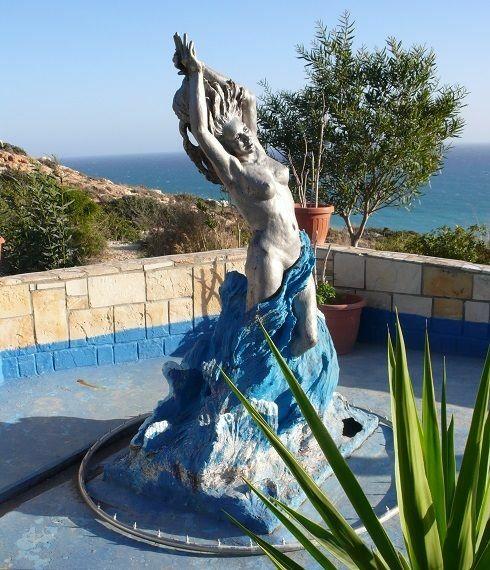
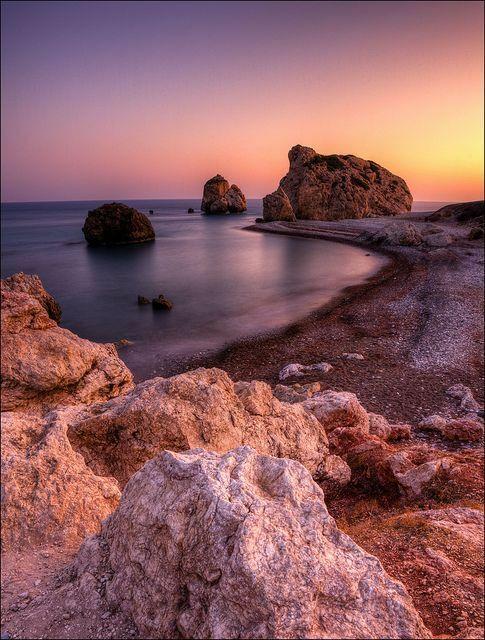
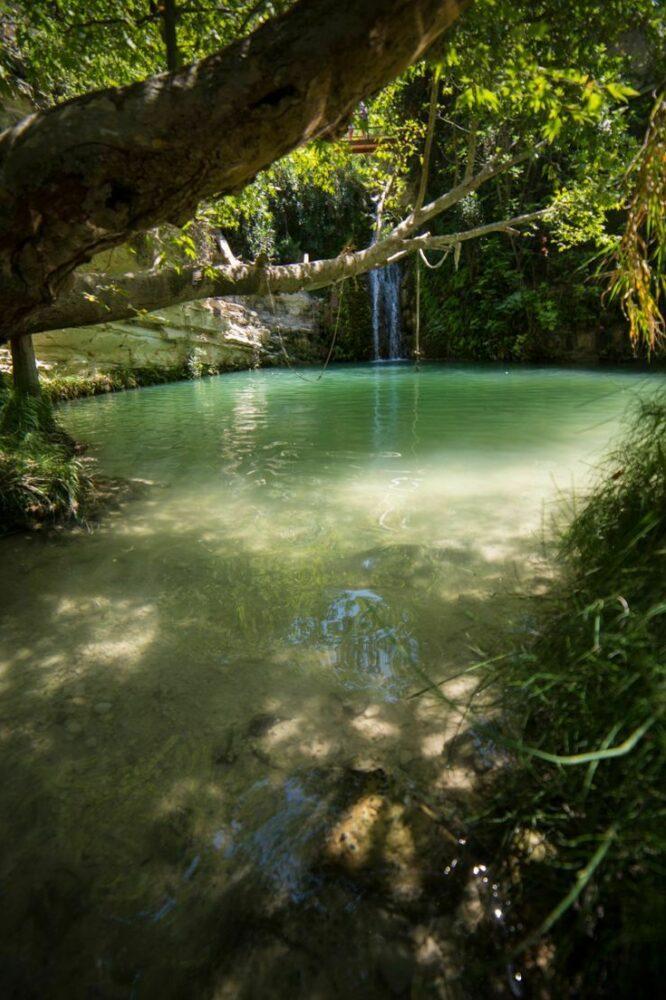
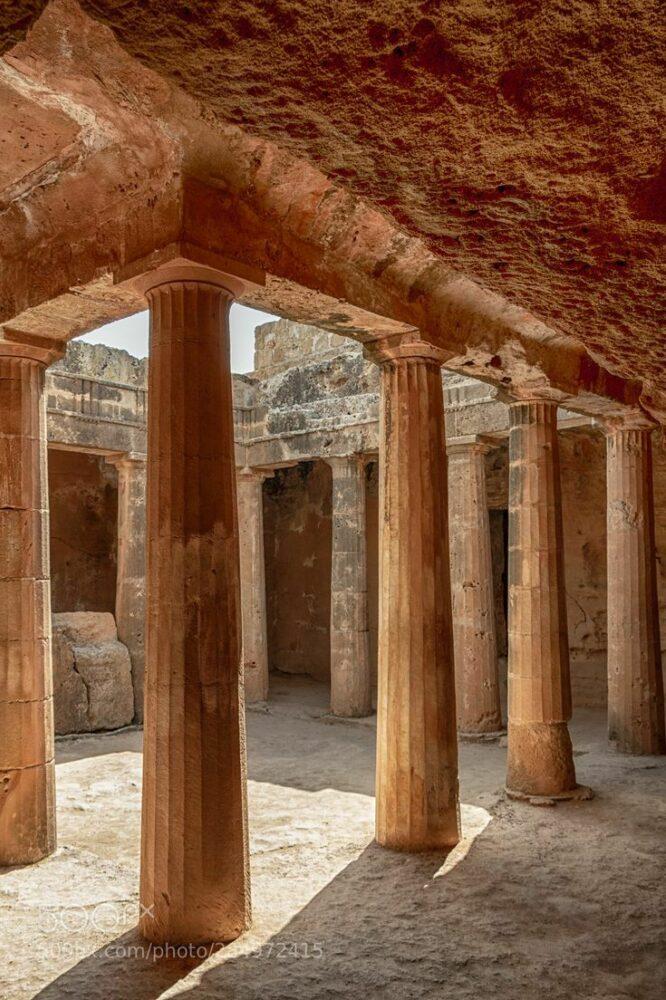
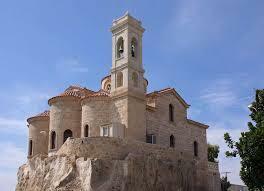
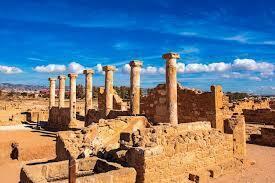
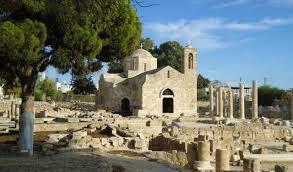
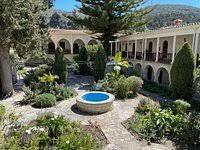

SACRED TRAVEL to the ancient island of CYPRUS. Allow yourself to immerse into the authentic Mediterranean experience of true Love and Beauty. Europe’s sunniest island and birthplace of Aphrodite is rich in sacred sites, those of both the Greek and the Roman. We will visit early Christian basilicas, Byzantine churches, monasteries and Gothic cathedrals. Amidst all this we will tour the Crusade Castles, Muslim mosques, ancient theaters, Greek Temples and spectacular villas. Many of these overlook the crystal clear waters of the Mediterranean. Much more which we will explore while feasting on the delicious Mediterranean cuisine, considered the world’s healthiest while staying in luxurious hotels, from authentic boutique to grand!
SACRED MYSTICAL JOURNEYS TO CYPRUS. Finbarr brings his gifts to this already gloriously sacred land. He feels into and acknowledges the energies that exist, all specifically chosen for their energetic and vibrational significance. With his 'deep knowing' after years of his own self discovery and personal work, Finbarr weaves in energetic practices, rituals and wisdom going layers beneath, giving the pilgrim an experience of 'off the beaten path' of the average tourist. He allows the experience to be both personal and collective; finding the places and spaces to step into mystical moments of true self discovery in the already sacred sites of Aphrodite, Dionysus and Mt. Olympus. All the while enjoying gorgeous vistas, charming and elegant hotels, meals that Finbarr has personally curated overlooking the picturesque seas of CYPRUS. Perhaps sipping the local wines, shopping in the fine village shops. One experiences the beauty of CYPRUS while being guided into the ancient wisdom for the true seeker.
TRAVEL ON THIS SACRED MYSTICAL JOURNEY TO CYPRUS, the third largest Island and the sparkling gem of the Mediterranean situated at the crossroads of three continents – Europe, Asia and Africa creating a precious biosphere protected by UNESCO. Experience the splendor of the Byzantine Empire which for many centuries encapsulated ancient CYPRUS. Become a part of this sacred land known also as the birthplace of Aphrodite, the Greek Olympian Goddess of Love, Pleasure, Eternal Youth and Beauty. We will visit places where Aphrodite is honored, untouched grottos nestled in pristine natural surroundings, gorgeous ocean views with superb light as the sun rises to the setting sun. We will SACRED TRAVEL to the past ways of life, customs and traditions. Here, festivities and activities whose origins harken back to the rich depths of antiquity are still being practiced today.
MOUNT OLYMPUS-(The Luminous One in Greek) The heavenly
mountain where legends were forged, starring the Twelve Gods, Muses and
the Graces. It is widely considered a ‘zone of great spiritual power
including superhuman strength, teleporting and omnipresence; the meeting
place of Heaven and Earth’. Certainly a place of awe and wonder for
travelers from all over the world. Many consider it a beacon of light
which emanates healing energy throughout the island and beyond.
DIONYSUS-THE SPIRIT OF FERTILITY- The Greek Nature God of Wine, Festivities, Frolick and Well-Being, lives on throughout the duration of the CYPRUS Wine Festivals. Along with dancing, celebration and abandon, award winning libations from the local vineyards are consumed along with world renowned wines. Lavish festivals in honor of Dionysus also known as Bacchus (Bacchian celebrations of ecstasy) were widely instituted centuries ago. He was worshiped for his expression of Revelry and Fruitfulness. Mythology has it that he was born twice and resurrected by his father Zeus, inspiring the power of Liberation, The Life Blood in Nature, Resurrection and Freedom. His place continues to inspire special importance for the power of art and literature in the Greek culture.
THE PICTURESQUE ISLAND GEM OF CYPRUS. The magical land of beauty and reverence for nature, all living things and the sacred is found in the easternmost part of Europe. It constitutes a cultural bridge between people of different religions, cultures and ways of life. Here a great variety of foods, art, music, languages and spiritual traditions can be experienced. A place of integrated love for all of life. With the glorious Troodos Mountain Range hosting the highest point in the country, Mount Olympus and the Troodos National forest, home to ancient ruins and extraordinary flora and fauna, the magnificence of this island cannot be overstated.
A BIT OF HISTORY In 330 A.D. the capital of the Roman
Empire was moved from Rome to Constantinople. Christianity was declared
the official religion of the state. In 395 A.D. the Roman Empire was
split into the Western Roman Empire and the Eastern Roman Empire. The
Eastern part, also known as the Byzantine Empire, included CYPRUS from
the 4th to the 12th centuries, and is considered the Early Christian-
Byzantine period.
In 488 A.D. Byzantine Emperor Zeno accorded the Archbishop of CYPRUS and his successors the privileges of wearing the purple cloak during official ceremonies, reserved for only the most virtuous and a symbol of imperial authority and status as well as awarding the honor of holding an imperial scepter and bearing the right to sign with the rare red ink. Archbishop Anthemios, wishing to express his gratitude to the Emperor for ratifying that the Church of CYPRUS would be autocephalous,(independent of external and especially patriarchal authority) presented him with St. Barnabas’ manuscript of St. Matthew's Gospel, which Archbishop Anthemios had discovered in the Apostle’s tomb near Salamis. A monastery dedicated to St. Barnabas was erected on the spot where his tomb was discovered. St. Barnabas is considered to be the founder of the Church of CYPRUS.
Today we start our journey in the seafront city of Larnaca at 9:00 a.m. With its rich history and cultural richness including many ancient Byzantine and Muslim monuments, we will enjoy the renowned landmark of Hala Sultan Tekkesi Mosque on the Westbank of Larnaca Salt Lake, considered one of the holiest places in Islam.
Next, the beautiful and intimate Kebir (Buyuk) Mosque which is known as the first Ottoman Mosque in CYPRUS. It was originally a Catholic church dedicated to St. Catherine in the 13th-14th century and holds great significance in the region.
Agios Lazaros Church and Ecclesiastical Museum - Also known as Saint Lazarus Church is a magnificent 9th century stone church. It was built by Byzantine Emperor Leo VI in the 9th century and restored in the 17th century. This church is one of the most remarkable examples of Byzantine architecture in CYPRUS. Saint Lazarus came to CYPRUS after being resurrected by Jesus and was ordained as Bishop of Kition by the Apostles. St. Barnabas and St. Paul lived here for 30 years. St. Lazarus’ tomb actually exists under the sanctuary. The iconostasis is a superb example of Baroque wood carving. Eight days before Easter a procession is held during which St. Lazarus’ icon is carried through the streets of Larnaca.
We will visit Larnaca Salt Lake, which is one of the most significant biotypes in all of Europe, including its habitats for waterfowl. Scores of flamingos, wild ducks and other water or shore fowl find refuge here in the winter on their migratory journeys. A place of great diversity ecosystems. A designated nature trail has been created along the flowering banks of the lake connecting the area with the Aphrodite route and winds up to the old aqueduct of Kamares. Known by the locals as Alyki, it has a rare complex network of four lakes containing different salts! A mystery of nature to be sure.
Late afternoon we travel to Paphos. Lunch on your own. We overnight in our Hotel in Paphos. (B. D)
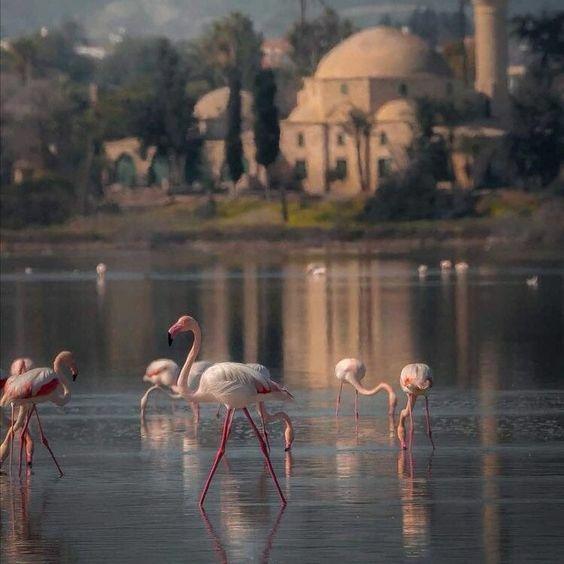
It is out of the seas of Paphos that Aphrodite, one of the 12 major Greek Olympian gods; the goddess of Love, Pleasure, Prosperity, Grace and Beauty is said to have been ‘born of sea foam’ and arrived on the shores of CYPRUS at Paphos. It was in Paphos that the worship of this goddess flourished. The essence of Aphrodite can still be felt today. Paphos is surrounded by a pristine and gorgeous coastline. Inland in the mountainous regions lay magnificent monasteries and tranquil villages, where the traditional ways and customs are still practiced today.
We will view the beautifully intricate mosaics in the House of Dionysus, House of Theseus, House of Aeon and the House of Orpheus. The mosaic floors of these Houses rival any mosaic art in Italy and date from the 2nd to the 5th century A.D. The masterfully and intricately created mosaics depict scenes from Greek mythology. Some of the mosaics depict the God of Wine, also known as Bacchus. Other scenes include that of Theseus depicting the classical Greek mythological hero brandishing a club against the rival Minotaur.
We will visit the “Tombs of the Kings”. These monuments consist of magnificent underground tombs carved out of the solid rock and date back to the 3rd century B.C. Some are decorated with Doric pillars considered the oldest Greek architecture design and symbolize power and strength.
Next we stop at Agia Solomoni Christian Catacomb, A small underground complex of chamber tombs from the classic Greek Hellenistic period which has been called the Chapel of the Seven Sleepers, or the Seven Maccabees. It was considered so sacred that almost every medieval pilgrim paid a visit. The complex was first used as a Christian catacomb in the 2nd century. There is a belief that it may have served as a synagogue before that. It houses stunning 12th century frescoes. Among the graffiti cut into the plaster are the names of 13th century Crusaders. A “sacred” pistachio tree grows above which, according to tradition, is believed to cure whoever hangs a personal votive offering on its branches. (AG??)
Today we visit a number of significantly sacred churches - The Basilica of Saint Paul's Pillar in The Basilica of Chrysopolitissa, Ayia Kyriaki Church and Theoskepasti Church -
The Basilica Chrysopolitissa including St. Paul’s Pillar was built in the 13th century over the ruins of the largest Early Byzantine Basilica on the island. St. Paul’s Pillar is situated in the church courtyard, where according to legend the Apostle was flogged before converting the then Roman Governor Sergius Paulus to Christianity. In the middle of this site is the medieval Ayia Kryiaki Church, built around 1500 AD. It is still operational as the main Anglican church in Paphos. This Greek Orthodox church was built to honor the Christian Saint Agia Kryiaki.
The Theoskepasti Church - The interpretation is “Veiled by God”. According to popular belief, the church was named thus, because God sent down a fog cloud to protect the original church during the Arab raids.
Agios Neofytos Monastery - One of the best known monasteries in CYPRUS was founded in the second half of the 12th century by the Cypriot recluse and writer, Neofytos. The ‘Enkleistra’, the cave that the hermit carved out of the mountains, is covered with some of the finest examples of Byzantine wall painting dating back to the 12th through 15th centuries. The monastery has a noteworthy ecclesiastical museum. The monastery church contains some of the most beautiful Post Byzantine icons dating from the 16th century.
The “Baths of Aphrodite” is in the Akamas; a promontory cape at the northwest extremity of CYPRUS. It derived its name from the small grotto shaded by an old fig tree. This small grotto is nestled in a botanical garden and nature trail. The waters flow down a wall of rock and form a pool amongst the moss. In these waters of which, mythological legend has it, the goddess Aphrodite bathed and is where she met her lover Adonis.
Kato Pyrgos is a quaint village nestled in the foothills of the Troodos Mountain Range with a stunning view of the sea. Kato Pyrgos is one of the few villages left in CYPRUS where the lush natural environment remains virtually untouched, maintaining the original stunning flora and fauna. It is an ideal spot for fishing and hiking. Rich in history and culture, Kato Pyrgos hosts many monuments, chapels and churches. Especially interesting is the chapel of the Virgin Mary Angeloktist. Based on the folk tradition, it was built by angels using milk instead of water. The Angeloktisti Church and chapel was completed around the 12th century and is in use in its original functioning today.
Petra Tou Romiou - (Aphrodite’s Rock) Birthplace of Aphrodite - The “Petra tou Romiou” with its crystal clear coastline, is where, according to mythology, Aphrodite rose from the waves or ‘sea foam’. The Greek name, “Petra tou Romiou” (“the Rock of the Greek'') is associated with the legendary Byzantine hero, Digenis Akritas, who, according to legend, kept the marauding Saracen Arabs (7th-10th centuries) at bay with his astounding strength. With one hand he was said to have grabbed hold of the Kyrenia mountain range thereby forming “Pentadaktylos'', the Five Fingered mountain, while with the other hand he heaved a huge rock and tossed it into the sea at the Saracens who were trying to land on the sand. The rock still remains and thus gave the region its name.
Sanctuary of Aphrodite - and the Palaepaphos Museum - Palaepaphos was one of the most celebrated pilgrimage centers of the classical Greek world and one of the most powerful city-kingdoms of CYPRUS in antiquity. Here lie the ruins of the very famous sanctuary of Aphrodite, whose remains date back to the 12th century B.C. The sanctuary continued to be a place of worship until the 3rd or 4th century AD. The museum is housed in a nearby Lusignan manor. It portrays how the Cult of the Goddess of Fertility developed into the Cult of Aphrodite.
Chrysorrogiatissa Monastery - Set in beautiful natural surroundings The Monastery of Chrysorrogiatissa is dedicated to ‘Our Lady of the Golden Pomegranate’. It was founded in 1152 by monk Ignatios who discovered a miraculous icon of the Virgin Mary off the shore of Paphos. Legend has it that it was thrown into the sea in Asia Minor during the iconoclastic period and drifted by the waves to Paphos. The monastery’s old winery produces some of the best vintage wines on the island.
Lunch on your own - We overnight at our hotel in Paphos for 4 nights.(B. D)
Today we depart for Lemesos - Agia Napa Church - The church was built in the form of a medieval castle towards the end of the 19th century and early 20th century, replacing an older 18th century church. It was dedicated to the Virgin Mary. According to tradition it takes its name from an icon of the Virgin Mary, which was found in a glen (Napa in Latin means glen). Another source says that the church owes its name to a temple built in the Frankish period, dedicated to the Holy Nappe of Saint Berenice, known by the name of Saint Nape. This Cathedral stands as a beacon of spiritual and architectural brilliance.
Kolossi Medieval Castle - We next visit this exquisite castle that was originally built in the 13th century and rebuilt in its present form in the 15th century. After the fall of Acre in 1291 it served as the Grand Commandery of the Knights of the Order of St. John of Jerusalem. In the 14th century it came under the domain of the Knights Templar. During their stay in CYPRUS, the Knights produced and exported a sweet wine, which became known as the “vin de Commanderie”. Today Commandaria wine is one of CYPRUS’ traditional wines. This wine is one of the oldest named wines in the world and is considered one of the most impressive in both history and quality of all the wines in its class.
Agai Anastasia Church -Here we have a complex of two churches. The older one, possibly dating back to the 12th century, is on the east side and is a cross-in square domed church. The second church on the west side was added in the 14th century and was built in the same architectural style. The surviving beautiful mural paintings date back to the 14th and 15th centuries.
Sanctuary of Apollon Hylates - Apollon Hylates, God of the Woodland, was the protector of Kourion. He was worshiped here from the 8th century BC to the 4th century AD. His sanctuary was an important religious center. It consisted of Apollo’s Temple, which has been partly restored, pilgrim halls, the ‘palaistra’, a bath complex, and a holy precinct.
Lunch on your own - We overnight at our hotel in Lemesos for 2 nights.(B. D)
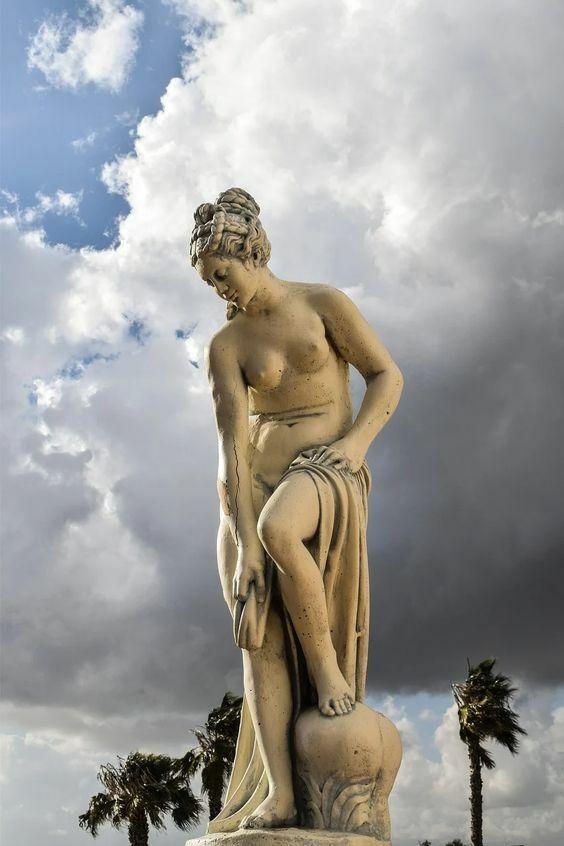
This morning we depart for Larnaca airport and the next leg
of our journey, grateful for all that we have experienced. On the
sacred island of CYPRUS, home of the Aphrodite spirit of Love, Eternal
Youth, Beauty, Fertility and Grace and the energy of Dionysus; Frolick,
Well Being and Free Spiritedness we are expanded and grounded in a most
spectacular way.
| Tour Price Includes | US Dollars |
| CYPRUS Tour Fee (Excluding Airfare) | $3577 |
| Discount for cash or check | $3500 |
| Single supplement rate additional | $600 |
| All entrance fees to sites | |
| All hotel accommodations | 6 nights |
| All ground and transportation | |
| Tips to drivers, guides, hotel and restaurant staff | *$100 per person included in the tour price |
| Full breakfast and dinner each day |
CYPRUS Tour Price Does *NOT* INCLUDE:
• International airfare
• Meals not mentioned above
• Extras at hotels
• Mineral water, tea, coffee, after meal beverages, personal expenses
(i.e laundry, valet service, telephone calls, postage, etc.)
$800 deposit secures your place on the journey with the balance due 60 days prior to departure.
For reservations call toll free 719 641 6764 or book online here.
Website: www.sacredmysticaljourneys.com
For Price in Euros or Pounds Sterling please email Customer Service